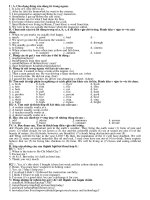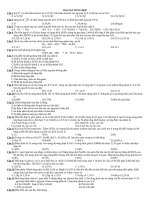Bài tập tổng hợp -B1-16, B2-16, B3-16
Bạn đang xem bản rút gọn của tài liệu. Xem và tải ngay bản đầy đủ của tài liệu tại đây (153.03 KB, 4 trang )
<span class='text_page_counter'>(1)</span><div class='page_container' data-page=1>
Molecular Detection of
Ehrlichia canis
in Dogs in
Malaysia
Mojgan Nazari1, Sue Yee Lim1, Mahira Watanabe2, Reuben S. K. Sharma2, Nadzariah A. B. Y. Cheng1,
Malaika Watanabe1*
1Department of Veterinary Clinical Studies, Faculty of Veterinary Medicine, Universiti Putra Malaysia, Selangor, Malaysia,2Department of Veterinary Pathology and
Microbiology, Faculty of Veterinary Medicine, Universiti Putra Malaysia, Selangor, Malaysia
Abstract
An epidemiological study of Ehrlichia canis infection in dogs in Peninsular Malaysia was carried out using molecular
detection techniques. A total of 500 canine blood samples were collected from veterinary clinics and dog shelters. Molecular
screening by polymerase chain reaction (PCR) was performed using genus-specific primers followed by PCR usingE. canis
species-specific primers. Ten out of 500 dogs were positive forE. canis. A phylogenetic analysis of theE. canisMalaysia strain
showed that it was grouped tightly with otherE. canisstrains from different geographic regions. The present study revealed
for the first time, the presence of genetically confirmedE. caniswith a prevalence rate of 2.0% in naturally infected dogs in
Malaysia.
Citation:Nazari M, Lim SY, Watanabe M, Sharma RSK, Cheng NABY, et al. (2013) Molecular Detection ofEhrlichia canisin Dogs in Malaysia. PLoS Negl Trop Dis 7(1):
e1982. doi:10.1371/journal.pntd.0001982
Editor:David H. Walker, University of Texas Medical Branch, United States of America
ReceivedFebruary 7, 2012;AcceptedNovember 5, 2012;PublishedJanuary 3, 2013
Copyright:ß2013 Nazari et al. This is an open-access article distributed under the terms of the Creative Commons Attribution License, which permits
unrestricted use, distribution, and reproduction in any medium, provided the original author and source are credited.
Funding:The research was supported in part by the Universiti Putra Malaysia, Research University Grant Scheme (Project no: 01-01-09-0662RU). The funders had
no role in study design, data collection and analysis, decision to publish, or preparation of the manuscript.
Competing Interests:The authors have declared that no competing interests exist.
* E-mail:
Introduction
Ehrlichia canis is a gram-negative obligatory intracellular
bacterium with a tropism for monocytes and macrophages in the
family Anaplasmataceaeand orderRickettsiales[1,2]. Canine
mono-cytic ehrlichiosis (CME) caused byE. canisis a tick-borne disease of
dogs. E. canis is transmitted by the brown dog tick Rhipicephalus
sanguineus[3,4]. The disease was first described in 1935 in Algeria,
as a febrile sickness associated with leukopenia, thrombocytopenia,
depression and anemia in several dogs [1]. Some closely related
pathogens, includingEhrlichia ewingii,Ehrlichia chaffeensis,Anaplasma
phagocytophilumand Neorickettsia risticii, are shown to cause similar
clinical and hematological manifestations in dogs as well [2,5].
However, E. canis is responsible for the most common and
clinically severe form of canine ehrlichiosis, and may also be a
cause of human ehrlichiosis [6,7].
Because rickettsiales are able to infect a broad range of hosts, and
multiple pathogens can co-exist in both vertebrate and invertebrate
hosts, the availability of a rapid, highly sensitive, and specific test
that can diagnose one or more pathogens, including co-infections, in
a test sample will be valuable for timely diagnosis and treatment
[8,9]. Traditional diagnostic techniques including hematology,
cytology, serology and isolation are valuable diagnostic tools for
CME, however it is believed that molecular techniques make the
most appropriate means of diagnosis ofE. canisinfection, and would
be useful for monitoring and controlling the spread of infection from
ticks [10]. Moreover, a multiplex molecular test would be a valuable
tool in studies to evaluate the impact of co-infections on the disease
outcome, as well as in studies to assess vaccines and therapeutics [9].
Microscopic visualization of morulae in peripheral blood leukocytes
may be the simplest test, but it is also the least sensitive technique.
Currently serological tests are the most commonly practiced method
for diagnosis ofE. canisinfection. These serological tests reflect the
quantity of antibodies present in the serum and therefore indicate
exposure but not the severity of disease and the duration of infection
[11]. Furthermore, antibodies are usually absent during the first two
weeks of onset [11]. Additionally antibodies against several other
ehrlichial organisms might cross-react withE. canisand complicate
the serological diagnosis [12]. False negative results are another
common feature of serological tests and may occur due to the early
stage of the disease and lack of antibody which may further impact
the final diagnosis [13].
Conversely, polymerase chain reaction (PCR) is a sensitive
method of detection of acute monocytic ehrlichiosis in dogs; in fact
it is designed to aim for the organism itself which makes PCR an
invaluable technique capable of detecting traces of pathogen even
before the onset of clinical signs [14]. Therefore, the advantages of
molecular detection of Ehrlichia include diagnosis before the
development of antibodies in early stages of disease and identifying
new species and also closely related species of Ehrlichia using
species-specific primers and sequencing [15].
To date the presence of ehrlichial agents in dogs in Malaysia has
not been investigated using molecular techniques and therefore,
this study was undertaken to detectE. canisDNA and to determine
the prevalence of the disease caused by this pathogen in dogs in
Malaysia.
Materials and Methods
Ethics statement
The research was conducted as per the guidelines of the Animal
Care and Use Committee, Faculty of Veterinary Medicine,
</div>
<span class='text_page_counter'>(2)</span><div class='page_container' data-page=2>
Universiti Putra Malaysia. This committee follows the Australian
code of practice for the care and use of animals for scientific
purposes. The committee did not deem it necessary for this
research group to obtain formal approval to conduct this study.
A total of 500 blood samples were collected from dogs in
Peninsular Malaysia, comprising 177 samples from stray dogs at
shelters around Selangor state (144) and Langkawi Island (33), and
323 samples from dogs that were presented to private veterinary
clinics from Selangor (86) Johor (30), Melaka (27), Sabah (3), and
the veterinary teaching hospital at Universiti Putra Malaysia
(UPM), Selangor (177) for routine health care or specific
treatment. Samples were collected in EDTA-anticoagulant tubes
once a week randomly from February 2009 to February 2010, and
stored at220uC until further use. Information (age, breed, sex,
and all laboratory results) of all the clinic cases was recorded, and
the sex of the stray dogs was noted (Table 1).
DNA extraction
DNA was extracted from whole blood (200ml) following the
QIAamp animal blood and Tissue Kit procedure (QIAGEN
GmbH, Hilden, Germany), adjusted in 200ml of Tris- EDTA (TE)
buffer and stored at220uC until further use.
PCR amplification
Standard screening conventional PCR was performed on all
500 samples using genus-specific primers; forward EHR16SD
(59-GGTACCYACAGAAGAAGTCC-39) and reverse EHR16SR
(59-TAGCACTCATCGTTTACAGC-39) [16]. Second PCR
was performed on positive samples in the screening PCR using
the E. canis species-specific set of primers; forward CANIS
(59-CAA-TTA-TTT-ATA-GCC-TCT-GGC-TAT-AGG-A-39) and
reverse GA1UR
(59-GAG-TTT-GCC-GGG-ACT-TCT-TCT-3)9 that amplifies approximately a 409 bp fragment of the 16S
rRNA gene ofE. canis[17,18]. After detecting positive samples, in
order to amplify a longer fragment of the 16SrRNA gene ofE.
canisincluding the divergent region, another PCR was performed
with oligonucleotide primers: FD1
(59-AGA-GTT-TGA-TCC-TGG-CTC-AG-39) and Rp2
(59-ACG-GCT-ACC-TTG-TTA-CGA-CTT-39) [19]. The PCR amplification was set up within a
25ml reaction mixture containing 5ml of DNA template and 20ml
of master mix (2.5ml 106buffer without MgCl2, 10mM of dNTP,
5 mM MgCl2, 0.8mM of each primer, 5 units of Taq polymerase,
and sterile distilled water to a final volume of 20ml). The thermal
cycling procedure was; 1 cycle of 5 minutes at 95uC, 40 cycles of
30 seconds at 95uC, 30 seconds at 62uC, 60uC or 63uC depending
on the primers used, 1.30 minutes at 72uC, and final cycle of
5 minutes at 72uC. Sterile distilled water and DNA of anE. canis
positive dog were included as a negative and positive control,
respectively.
The amplification products were visualized on a 1.5% agarose
gel after electrophoretic migration for 40 minutes at 100 voltages.
The gels were stained with ethidium bromide for 10 minutes and
visualized by UV illumination.
Sequence and similarity analysis
Amplicons were extracted using the QIAPCR purification kit
(QIAGEN) for direct sequence analysis using ABI prismTM
BigdyeTM terminator cycle sequencing Ready reaction kit V.3.1.
All sequences were aligned manually using ClustalW program
(www.ebi.ac.uk/clustalw). For comparing and analyzing the
nucleotide sequences the BLAST program (i.
nlm.nih.gov/BLAST) was used. A similarity tree was inferred
using the neighbor- joining method, MEGA software version 5.
Statistical analysis
The statistical analysis was performed using the chi-square test
and the Fisher exact test to determine the relation between the
observed variables; prevalence between the stray dogs and clinic
cases, sex of the animals (male and female), age, clinical signs
(symptomatic or asymptomatic) and the dispersion of these
frequencies.
Results
Five hundred blood samples (323 clinic cases and 177 stray
dogs) were evaluated using PCR in this study out of which ten
were identified asE. canis positive, giving an overall prevalence
rate of two (2.0%) percent. The prevalence of E. canis was
calculated as 1.2% (4 of 323) amongst the clinic group, and 3.4%
(6 of 177) among the stray dogs. There was no significant
difference in the prevalence ofE. canis between stray dogs and
clinic cases (X2= 0.400,P= 0.527). The amplification with
species-specific primers CANIS/GA1UR produced a clear single band of
approximately 409 bp (Figure 1). The ten positive PCR products
Table 1.Summary of prevalence ofE.canisamong clinic cases
based on sex, breed and age.
Criteria
Total number of
dogs
No ofE. canispositives
(%)
Sex Male 171 4 (2.3)
Female 152 0 (0.0)
Breed Pure-breed 168 0 (0.0)
Cross-breed 155 4 (2.6)
Age (years) 0–3 119 2 (1.7)
3–6 84 1 (1.2)
6–9 76 1 (1.1)
9–12 34 0 (0.0)
12–15 10 0 (0.0)
Total 323 4 (1.2)
doi:10.1371/journal.pntd.0001982.t001
Author Summary
Canine vector-borne diseases are a worldwide concern
particularly in the tropics and sub-tropics that provide
favourable climatic conditions for the vectors. Malaysia, a
tropical paradise, is thus home to a wide range of vectors
as well as the pathogens that they harbor.Ehrlichia canis, a
ubiquitous tick-borne pathogen of dogs, is the causative
agent of canine monocytic ehrlichiosis, the most common
clinically significant tick-borne disease of dogs in Malaysia.
The pet explosion coupled with the increasing number of
stray dogs, has resulted in a surge in vector-borne diseases
in companion animals in Southeast Asia. Despite this, there
is very little published information regarding this subject in
Malaysia. There are only two published studies onE.canis
in Peninsular Malaysia based on traditional light
micro-scopic detection and antibody detection techniques. This
disease has been notoriously difficult to diagnose based
on the traditional methods. This research investigates this
important disease of canids using molecular techniques for
the first time in Malaysia providing a more accurate picture
of its presence and prevalence in the country.
E. canisin Dogs in Malaysia
</div>
<span class='text_page_counter'>(3)</span><div class='page_container' data-page=3>
were purified and sequenced. BLAST analysis confirmed the
isolation ofE. caniswith 100% identity to other registeredE. canis
strains in GenBank. The nucleotide sequence was deposited in
NCBI GenBank database (accession number JF429693.1). This is
the first confirmed detection of E. canis DNA from dogs in
Malaysia.
Among the clinic cases 27 (8.3%) dogs had both
thrombocy-topenia and anemia, but only one of them was positive forE. canis.
However thrombocytopenia appeared to be more consistently
associated with the disease as three out of four positive dogs had
thrombocytopenia and this proved to be of statistical significance
(P= 0.017).
The major part of the 16S rRNA sequences (1384 bp) using
primers FD1/Rp2, amplified from theE. canispositive dogs, was
100% identical with the corresponding sequences from E. canis
strains in different geographical areas of the world. Nucleotide
differences in 16S rRNA sequences among E. canis strains from
different geographical areas showed very few differences. AnE.
canis similarity tree was inferred using the neighbor- joining
method, MEGA software version 5. A similarity tree ofE. canis
Malaysia based on nucleotide sequences showed that the Malaysia
strain was grouped tightly with otherE. canisstrains from different
geographic regions (accession numbers EU263991.1,
EU106856.1, AF373613.1).
Discussion
In the present study E. caniswas successfully amplified using
molecular techniques and this represents the first molecular survey
of this pathogen in Malaysia. The only published investigation
based on detection ofE. canisvia light microscopic examination of
peripheral blood films was carried out over 25 years ago revealing
a prevalence rate of only 0.2% in dogs, and recently the
prevalence of E. canis infection was determined to be 15% in
Perak state of Malaysia using indirect immunofluorescence assay
(IFA) [20,21].
Due to limitations of light microscopic examination for the
detection of E. canis, it was imperative to study the prevalence
using more reliable diagnostic methods. Furthermore, due to high
prevalence rates of even up to 30% around the world, and because
Ehrlichia species are the etiological agents of emerging and
life-threatening tick-borne disease in domestic animals, there was a
pressing need to determine actual prevalence rates in Malaysia
[22–24].
In the current study, a relatively large number of blood samples
from both stray dogs and clinic cases were subjected to PCR, a
rapid, highly sensitive, and specific method for the detection ofE.
canis. The study revealed that the molecular prevalence ofE. canis
in the tested samples was 2.0%. This low prevalence rate is
interesting, as one would expect Malaysia to be a highly endemic
region forE. canisdue to the suitable climate and the abundance of
the tick vector. Thus further studies are needed to detectE. canis
DNA from ticks, as there would be no transmission to dogs if the
ticks are not infected.
Prevalence rates were low in both clinic cases and stray dogs.
The reasons for the low detectable rates requires further
investigation however it is important to bear in mind that
subclinical and chronic ehrlichial infections are not as readily
diagnosed as acute infections when canine blood is used for the
detection ofE. canis. Therefore, ideally, PCR using both blood and
splenic aspirates should be considered to overcome this limitation
[25]. Furthermore PCR sensitivity varies between laboratories and
Figure 1. 1.5% agarose gel stained with ethidium bromide.
Amplification of the 16S rRNA gene with CANIS/GA1UR primers,
approximately 409 bp, lane M = 100 bp DNA ladder, lane P = positive
control, lane 1–7 = positive samples, lane N = negative control.
doi:10.1371/journal.pntd.0001982.g001
Table 2.Association betweenE.canisinfection status and abnormal laboratory findings for clinic cases.
Lab findings
No of test positives/
No tested (%)
No ofE. canispositives/No of
test positives (%) Normal values
Thrombocytopenia 55/323 (17%) 3/55 (5.4%) 200–5006109
/L
Thrombocytosis 8/323 (2.5%) 0/8 (0%) 200–5006109
/L
Anemia 65/323 (20.1%) 1/65 (1.5%) 0.35–0.55 L/L
Hypoalbuminemia 47/323 (14.6%) 2/47 (4.2%) 25–40 g/L
Hyperalbuminemia 37/323 (11.5%) 0/37 (0%) 25–40 g/L
Lymphopenia 36/323 (11.1%) 0/36 (0%) 1.5–4.86109
/L
Lymphocytosis 5/323 (1.5%) 0/5 (0%) 1.5–4.86109
/L
Hyperglobulinemia 84/323 (26.2%) 2/84 (2.3%) 25–45 g/L
Hypoglobulinemia 19/323 (5.9%) 0/19 (0%) 25–45 g/L
Neutrophilia 61/323 (18.9%) 0/61 (0%) 3–11.56109/L
doi:10.1371/journal.pntd.0001982.t002
E. canisin Dogs in Malaysia
</div>
<span class='text_page_counter'>(4)</span><div class='page_container' data-page=4>
this fact may have contributed to the low number of positive dogs
identified.
Analysis of laboratory findings of clinic dogs revealed few
associations between hematological findings andE. canisinfection
status (Table 2). Furthermore, although 5 (1.5%) dogs had
laboratory findings typical of CME: thrombocytopenia, anemia,
and lymphopenia, none were positive forE. canis. Among the clinic
cases 27 (8.3%) dogs had both thrombocytopenia and anemia, but
only one of them was positive forE. canis. These results however
highlighted an important point; over diagnosis or misdiagnosis
may result if a diagnosis is made solely on clinical or hematological
findings as they are not specific for CME. At the same time it may
also have been possible that some of these dogs were subclinically
or chronically infected and thus had lab findings consistent with
CME but PCR was unable to detect the organism. Therefore a
reliable diagnosis of E. canis can only be made based on a
combination of clinical signs, laboratory test results, serological
tests, and molecular methods of detection.
As this was the first molecular study ofE. canisit was imperative
to carry out genetic characterization of the Malaysian strain for a
better understanding of the pathogen in Malaysia. All 1384 base
pair (bp) amplified sequences of the E. canis 16S rRNA of the
Malaysia strain were found to be identical to other deposited
strains in NCBI GenBank. Nucleotide differences in 16S rRNA
sequences amongE. canisstrains from different geographical areas
showed very few differences which could be explained by the fact
that the genetic profile of canineE. canisstrains based on the 16S
rRNA gene is highly conserved.
In conclusion,E. canisDNA was detected for the first time from
dogs in Malaysia and the overall prevalence rate of E. canis in
naturally infected dogs was 2.0%. The detection ofE. canisDNA
via PCR in this study confirms the presence of the infection in
both the pet and stray dog populations in Malaysia.
Acknowledgments
The authors would like to thank all the small animal clinics for providing
blood samples, and also all the labs and personnel of the Faculty of
Veterinary Medicine, Universiti Putra Malaysia.
Author Contributions
Conceived and designed the experiments: Malaika Watanabe. Performed
the experiments: Mojgan Nazari Sue Yee Lim Mahira Watanabe Malaika
Watanabe. Analyzed the data: Mojgan Nazari Malaika Watanabe.
Contributed reagents/materials/analysis tools: Reuben S.K Sharma
Nadzariah A.B.Y Cheng Malaika Watanabe. Wrote the paper: Mojgan
Nazari Malaika Watanabe.
References
1. Donatien A, Lestoquard F (1935) Existence en Algerie d’une rickettsia du chien.
Bull. Soc Pathol Exot 28: 418–419.
2. Dumler JS, Barbet AF, Bekker CP, Dasch GA, Palmer GH, Ray SC, Rikihisa Y,
Rurangirwa FR (2001) Reorganization of genera in the families Rickettsiaceae
and Anaplasmataceae in the order Rickettsiales: unification of some species of
Ehrlichia with Anaplasma, Cowdria with Ehrlichia and Ehrlichia with
Neorickettsia, descriptions of six new species combinations and designation of
Ehrlichia equi and ‘HGE agent’ as subjective synonyms of Ehrlichia
phagocytophila. Int J Syst Evol Microbiol 51:2145–65.
3. Lewis Jr GE, Ristic M, Smith RD, Lincoln T, Stephenson EH (1977) The brown
dog tick Rhipicephalus sanguineus and the dog as experimental hosts of
Ehrlichia canis. American Journal of Veterinary Research 38: 1953–1955.
4. Groves MG, Dennis GL, Amyx HL, and Huxsoll DL (1975) Transmission of
Ehrlichia canis to dogs by ticks (Rhipicephalus sanguineus) Am J Vet Res 36:
937–940.
5. Dawson J, Anderson B, Fishbein D, Sanchez J, Goldsmith C, et al. (1991)
Isolation and characterization of anEhrlichiasp. from a patient diagnosed with
human ehrlichiosis. Journal of Clinical Microbiology 29: 2741.
6. Perez M, Rikihisa Y, Wen B (1996) Ehrlichia canis-like agent isolated from a
man in Venezuela: antigenic and genetic characterization. Journal of Clinical
Microbiology 34: 2133–2139.
7. Perez M, Bodor M, Zhang C, Xiong Q, Rikihisa Y (2006) Human infection with
Ehrlichia canis accompanied by clinical signs in Venezuela. Annals of the New
York Academy of Sciences 1078: 110–117.
8. Aguirre E, Sainz A, Dunner S, Amusategui I, Lo´pez L, et al. (2004) First
isolation and molecular characterization ofEhrlichia canisin Spain. Veterinary
Parasitology 125: 365–372.
9. Sirigireddy K, Ganta R (2005) Multiplex detection of Ehrlichia and Anaplasma
species pathogens in peripheral blood by real-time reverse
transcriptase-polymerase chain reaction. Journal of Molecular Diagnostics 7: 308.
10. Harrus S, Waner T (2010) Diagnosis of canine monocytotropic ehrlichiosis
(Ehrlichia canis): an overview. Vet J 187(3):292–6.
11. Neer T, Breitschwerdt E, Greene R, Lappin M (2002) Consensus statement on
ehrlichial disease of small animals from the infectious disease study group of the
ACVIM. Journal of Veterinary Internal Medicine 16: 309–315.
12. Waner T, Harrus S, Jongejan F, Bark H, Keysary A, et al. (2001) Significance of
serological testing for ehrlichial diseases in dogs with special emphasis on the
diagnosis of canine monocytic ehrlichiosis caused byEhrlichia canis. Veterinary
Parasitology 95: 1–15.
13. Hegarty B, Levy M, Gager R, Breitschwerdt E (1997) Immunoblot analysis of
the immunoglobulin G response to Ehrlichia canis in dogs: an international
survey. Journal of Veterinary Diagnostic Investigation 9: 32.
14. McBride J, Corstvet R, Gaunt S, Chinsangaram J, Akita G, et al. (1996) PCR
detection of acute Ehrlichia canis infection in dogs. Journal of Veterinary
Diagnostic Investigation 8: 441.
15. Chen S, Dumler J, Bakken J, Walker D (1994) Identification of a
granulocytotropic Ehrlichia species as the etiologic agent of human disease.
Journal of Clinical Microbiology 32: 589.
16. Gal A, Loeb E, Yisaschar-Mekuzas Y, Baneth G (2008) Detection ofEhrlichia
canisby PCR in different tissues obtained during necropsy from dogs surveyed
for naturally occurring canine monocytic ehrlichiosis. The Veterinary Journal
175: 212–217.
17. Inokuma H, Beppu T, Okuda M, Shimada Y, Sakata Y (2003) Epidemiological
survey of Anaplasma platys and Ehrlichia canis using ticks collected from dogs in
Japan. Veterinary Parasitology 115: 343–348.
18. Inokuma H, Parola P, Raoult D, Brouqui P (2001) Molecular survey ofEhrlichia
infection in ticks from animals in Yamaguchi Prefecture, Japan. Veterinary
Parasitology 99: 335–339.
19. Parola P, Roux V, Camicas J, Baradji I, Boroqui P, et al. (2000) Detection of
Ehrlichiain african ticks by polymerase chain reaction. Transactions Of The
Royal Society Of Tropical Medicine And Hygiene 6: 707–708.
20. Rajamanickam C, Wiesenhutter E, Zin F, Hamid J (1985) The incidence of
canine haematozoa in Peninsular Malaysia. Veterinary Parasitology 17: 151–
157.
21. Rahman WA, Ning CH, Chandrawathani P (2010) Prevalence of canine
ehrlichiosis in Perak State, Penisular Malaysia. Tropical Biomedicine 27: 13–18.
22. Dagnone AS, de Morais HSA, Vidotto MC, Jojima FS, Vidotto O (2003)
Ehrlichiosis in anemic, thrombocytopenic, or tick-infested dogs from a hospital
population in South Brazil. Veterinary Parasitology 117: 285–290.
23. Bulla C, Takahira R, Arau´jo Jr J, AparecidaTrinca L, Lopes R, et al. (2004) The
relationship between the degree of thrombocytopenia and infection withEhrlichia
canisin an endemic area. Veterinary Research 35: 141–146.
24. Ndip LM, Ndip RN, Esemu SN, Dickmu VL, Fokam EB, et al. (2005) Ehrlichial
infection in Cameroonian canines by Ehrlichia canis and Ehrlichia ewingii.
Veterinary Microbiology 111: 59–66.
25. Harrus S, Kenny M, Miara L, Aizenberg I, Waner T, et al. (2004) Comparison
of simultaneous splenic sample PCR with blood sample PCR for diagnosis and
treatment of experimental Ehrlichia canisinfection. Antimicrobial Agents and
Chemotherapy 48: 4488.
E. canisin Dogs in Malaysia
</div>
<!--links-->









